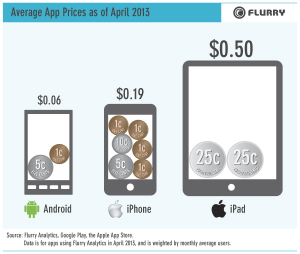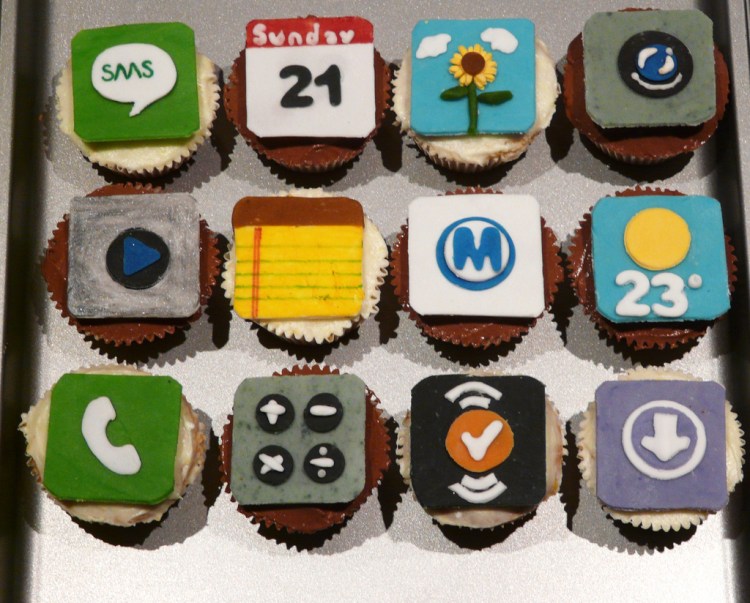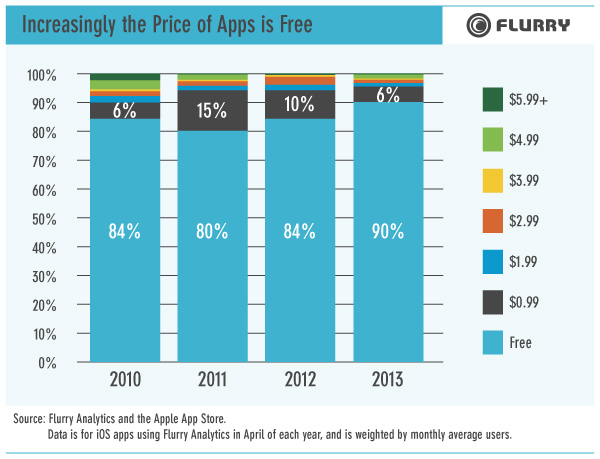We all hate advertising, right?
Wrong.
In fact, the vast majority of us are very happy to have advertising, according to a recent report by Flurry, which powers analytics for nearly 350,000 apps. The evidence? In 2011, 80 percent of apps were free. Today, 90 percent of apps are free, with monetization provided via good old we-gather-an-audience-and-sell-its-attention strategy that has worked since the dawn of modern media.
By inevitable corollary, the slice of apps that ask us to fork over cold hard cash has shrunk to a skinny little 10 percent wedge.
“We simply see this as the outcome of consumer choice: People want free content more than they want to avoid ads or to have the absolute highest quality content possible,” Flurry’s Mary Ellen Gordon writes.
That data is from the Apple app store, which has the best historical data, Flurry says, since it has been in operation longest. But Android pricing is even cheaper — yes, the perception is reality — and there’s really only one place where we’re paying somewhat significant prices for apps.
That would be iPad.
 iPad app pricing has traditionally been higher than iPhone or Android, and Flurry’s numbers bear that out. While the average app on Google Play is just $0.06 and the average app for iPhone is $0.19, iPad’s average app price is $0.50. That’s almost nine times the average Android price and 2.5 times the average iPhone price.
iPad app pricing has traditionally been higher than iPhone or Android, and Flurry’s numbers bear that out. While the average app on Google Play is just $0.06 and the average app for iPhone is $0.19, iPad’s average app price is $0.50. That’s almost nine times the average Android price and 2.5 times the average iPhone price.
Flurry says that’s because “iPad users tend to be bigger spenders than owners of other devices, including iPhone,” and while there’s some overlap between the circle of iPad owners and iPhone owners, iPad owners have higher incomes than iPhone or Android users.
Interestingly, Flurry tested if the pricing behavior — trending to free — was just a result of developer groupthink, or a result of actual informed decision-making.
What the company discovered is that developers who have done pricing experiments such as reducing the price of an app to free to boost downloads for a day or week tend to make the experiment the rule. In other words, once developers have tasted the flow of users that results from free, they get addicted and keep their app free.
Which, of course, means more ads for all of us.
But, we seem to be OK with that.
“While consumers may not like in-app advertising, their behavior makes it clear that they are willing to accept it in exchange for free content, just as we have in radio, TV and online for decades,” Gordon writes. “In light of that, it seems that the conversation about whether apps should have ads is largely over.”
VentureBeat's mission is to be a digital town square for technical decision-makers to gain knowledge about transformative enterprise technology and transact. Learn More


